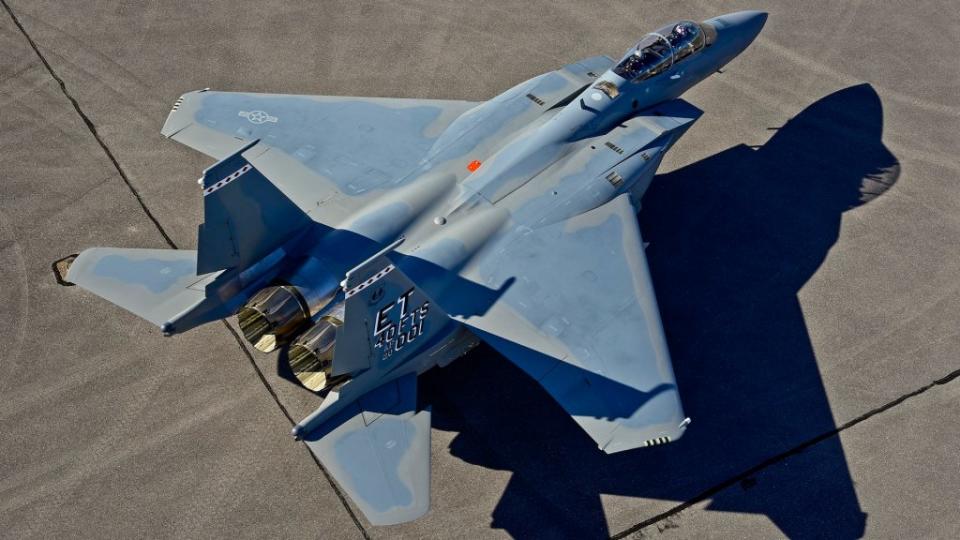In its latest annual report, the Office of the Director, Operational Test & Evaluation (DOT&E) provides an absolutely glowing assessment of the F-15EX Eagle II, the latest fighter to enter U.S. Air Force service. However, the assessment also offers a note of caution, especially when it comes to the survivability of the fighter when faced with potential future threats.
In the report, the Pentagon provides an update on the status of the F-15EX, which was approved for full-rate production in June of last year. It also reinforces the fact that, at present, the two-seat F-15EX is primarily an air superiority platform, despite its multirole capability.

An F-15EX arrives at Eglin Air Force Base, Florida. The aircraft is the first in the Air Force to be tested and fielded from beginning to end through combined developmental and operational tests. The 40th Flight Test Squadron and the 85th Test and Evaluation Squadron personnel are responsible for testing the aircraft. U.S. Air Force U.S. Air Force photo/1st Lt. Karissa Rodriguez
The F-15EX could potentially take on a multi-role mission once it’s established in service, but for now, the air-to-air mission is the priority. Specifically, the report notes, this includes missions such as offensive counter-air, cruise-missile defense, and defensive counter-air capabilities, including escort of high-value airborne assets. At this point, the F-15EX has only “a limited capability to employ precision-guided, air-to-surface munitions.”
With that in mind, the DOT&E report outlines the results of tests that assessed the F-15EX primarily against the kinds of threats it might encounter in the air-to-air part of its mission set. Here, the Eagle II appears to have passed with flying colors.
“Against the level of threat tested, the F-15EX is operationally effective in all its air superiority roles, including defensive and offensive counter-air against surrogate fifth-generation adversary aircraft, as well as basic air-to-ground capability against the tested threats,” the report notes. The reference to the F-15EX’s effectiveness against fifth-generation threats is especially notable. While it’s unclear exactly what kinds of threats are being referred to, a fifth-generation fighter will typically have a low-observable design, advanced ‘sensor fused’ avionics, and generally high performance, among other attributes. Prior to the F-35, the fifth-generation rubric often included extreme agility and supercruise, but definitions for generations of fighters are highly subjective and change with the times. You can read more about this reality here.

An F-15EX undergoes testing at Eglin Air Force Base in Florida. Jamie Hunter Jamie Hunter
Critics of the F-15EX have, in the past, suggested that the aircraft would not be able to compete on level terms with fifth-generation types, since it’s after all a heavily upgraded fourth-generation design, the first prototype of which flew in 1972. Regardless, the report seems to put such concerns aside, at least in the air-to-air arena, and based on the currently available test data.
Furthermore, “The F-15EX was able to detect and track all threats at advantageous ranges, use onboard and off-board systems to identify them, and deliver weapons while surviving,” the report continues.
While it has clearly excelled in simulated air-to-air combat, the F-15EX also wins plaudits from the Pentagon on account of meeting “all its reliability, availability, and maintainability requirements,” and achieving “nearly all objectives although maintenance technical orders were still immature.” This is a huge achievement as the reliability of modern fighters has become nearly as big of a concern as their basic capabilities, with fifth-generation types struggling in this regard.
Compared with the ‘legacy’ Eagle, the F-15EX boasts a much-enhanced cockpit, including a large touchscreen display, which you can read more about here. The crew are each provided with Digital Joint Helmet Mounted Cueing Systems (D-JHMCS).

The cockpit of an F-15 with the new Large Area Display and low-profile head-up display. Boeing
The cockpit environment is singled out for praise in the report, with survey data assessing human-systems interactions indicating that the pilots had positive opinions of F-15EX cockpit usability.
However, the report does highlight some potential concerns that were raised during the initial operational test & evaluation (IOT&E). Here, the Pentagon notes that, while adequate for the current F-15EX mission set, the threat level was not representative of some of the kinds of higher-end threats that the aircraft may encounter in the future.
“The mission-level testing did not include some advanced, longer-range threat weapons becoming operational at the time of F-15EX fielding.” As a result, the report continues, follow-on testing will be required “to assess the system against higher threat levels in more complex mission scenarios.”

An F-15EX fires an AIM-120D AMRAAM missile during a test mission near Eglin Air Force Base, Florida. U.S. Air Force photo by Tech. Sgt. John Raven The F-15EX Eagle II fires an AIM-120D missile during a test mission near Eglin Air Force Base, Fla, Jan 25, 2022. The F-15EX can carry up to 12 AIM-120D missiles. (U.S. Air Force photo by Tech. Sgt. John Raven)
More details weren’t provided, although the “advanced, longer-range threat weapons” would appear to be a reference to one or more of the new Chinese air-to-air missiles currently coming online or poised to do so.
China is known to be working on further-reaching air-to-air missiles, including the big PL-17, a very long-range missile that may well be intended primarily to target high-value assets, like tankers and airborne early warning aircraft. You can read more about this still-mysterious missile here.

A Chinese J-16 fighter armed with the very long-range PL-17 missile. Chinese Internet
As well as the more specialized PL-17, there is also another new Chinese air-to-air missile, currently dubbed PL-16, the design of which seems to have been driven by the requirement for the Chinese J-20 stealth fighter to accommodate six longer-range missiles internally. In the past, Douglas Barrie, the Senior Fellow for Military Aerospace at the International Institute for Strategic Studies (IISS) think-tank told TWZ that the PL-16 will likely feature “an active electronically scanned front end, Mach 5-plus fly-out, a lot of very capable onboard software, and be very resistant to jamming.”
There’s no doubt that China is making rapid progress in air-to-air missiles, with even the relatively well-established PL-15 thought to out-range the U.S.-made AIM-120C/D AMRAAM series. Indeed, the Air Force has publicly said that the emergence of the PL-15 was a key factor in the decision to start the AIM-260 program to provide a longer-range AMRAAM successor.

Four dummy PL-15 missiles in the weapons bay of a J-20. Chinese Internet
It’s notable, too, that the F-15EX has also been earmarked as a potential platform for the carriage of new and larger long-range air-to-air missiles, as you can read about here.
The report points out that some of the difficulty in obtaining the required test data for the F-15EX has resulted from the limitations in existing open-air range infrastructure. This is something that will only become more acute as missile ranges increase — not to mention the need to conduct these kinds of tests away from the prying eyes of potential adversaries. With this in mind, the F-15EX test campaign may, in the future, make use of the Joint Simulation Environment (JSE). This is a facility offering a so-called “software battlespace environment,” for testing and training that cannot currently be conducted on the Pentagon’s major physical test and training ranges.

An artist’s rendering showcases a Joint Simulation Environment station. U.S. Air Force graphic illustration courtesy of 412th Electronic Warfare Group
With the F-15EX now in Air Force service, the generally highly positive results of its operational testing thus far will be a significant confidence boost for the service and for manufacturer Boeing. Time will tell how the F-15EX copes with the kinds of “advanced, longer-range threat weapons” that it hasn’t currently been pitted against in test simulations. But provided it continues to excel, this could be another strong argument for the Air Force looking to acquire more than the 98 F-15EX aircraft that it now plans to buy.
Contact the author: thomas@thewarzone.com
#F15EX #Nails #Pentagon #Test #Campaign #Survivability #Concerns #Remain












Leave a Reply